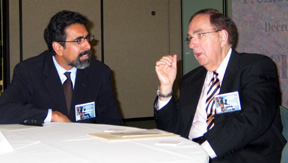 |
Guadalupe Pacheco and UNMC Chancellor Harold M. Maurer, M.D. |
Studies show major differences in health-care outcomes are based on socio-economic status, ethnicity, geography, age and education, as well as biases, prejudice and stereotypes.
On Oct. 23, UNMC began a community conversation to eliminate health disparities in Omaha with approximately 90 health-care providers, consumers, educators and policy makers attending a daylong conference.
“It’s a very critical issue,” said UNMC Chancellor Harold M. Maurer, M.D. “Our goal is to eliminate or, at the least, reduce health disparities in a microcosm of our world.”
 |
UNMC’s Aura Whitney-Jackson, center, attends the daylong conference. |
“Your organization should be reflective of the community you serve,” said keynote speaker Guadalupe Pacheco, public health advisor and special assistant to the deputy assistant secretary for minority health with the U.S. Department of Health and Human Services. “Becoming aware of your own attitudes, beliefs, biases and behaviors that influence patient care can help improve care access and quality.”
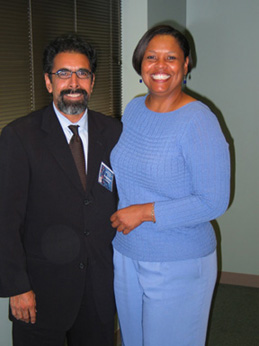 |
Valda Boyd Ford and Guadalupe Pacheco. |
Within the CLAS standards, there are four mandates, which require health-care organizations to:
- Offer and provide language assistance services, including bilingual staff and interpreter services, at no cost to each patient/consumer with limited English proficiency at all points of contact, in a timely manner, during all hours of operation.
- Provide to patients in their preferred language, both verbal offers and written notices informing them of their right to receive language assistance services.
- Assure the competence of language assistance to patients by interpreters and bilingual staff. A patient’s family and friends should not be used to provide interpretation services; and
- Make available easily understood patient-related materials and post signage in the languages of the commonly encountered groups and/or groups represented in the service area.
“Nebraska’s state slogan is Nebraska: The Good Life,” said Valda Boyd Ford, director of Community and Multicultural Affairs at UNMC. “But, who is it good for? Racial and ethnic minorities, in particular, continue to have health outcomes that are less positive than those of the general population.”
Meetings will be held in November and December with those who expressed a desire to be a part of the solution, Ford said. “Our intention is to develop collaborations and partnerships that fill in the gaps that presently exist in service delivery,” she said.
The group also will develop a list of resources and services available and work on eliminating disparities in physical and mental health and those caused by differences in language and culture.
Health disparities – what do they look like?
Disparities in health care are all around us.
They are in the faces of the homeless at the Siena/Francis House.
They are in the faces of African Americans at the Charles Drew Health Center.
They are in the faces of new immigrants and refugees to Omaha.
And they’re in the faces of the uninsured, and underinsured, who live at the doors of the emergency room.
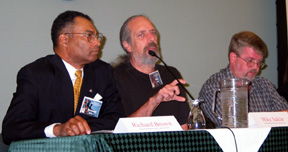 |
Panel members, from left to right, Richard Brown, Mike Saklar and Ed Leahy. |
“Where community health centers exist, the disparities decrease,” said Richard Brown, chief executive officer of Charles Drew Health Center, one of five community health centers in the state which offer services on an ability-to-pay basis.
Mike Saklar, executive director of the Siena/Francis House, the region’s largest homeless shelter, said there is a disconnect in the perception of mental and physical health. “To me it’s basically the same,” he said. “If we spent 10 times more on mental health, we’d probably spend 10 times less on physical health.”
“Disparity depends on one’s status, not just one’s class,” said Ed Leahy, coordinator of the Iowa-Nebraska Immigrant Rights Network. “Immigrants often don’t come with the mentality that one’s health is something to not only protect, but nurture.”
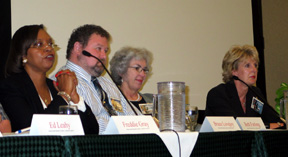 |
Panel members, from left to right, Freddie Gray, Bruce Lovejoy, Beth Furlong and Adi Pour. |
Beth Furlong, associate professor at Creighton University School of Nursing, said she is concerned with the lack of access to health care, saying 9 percent of Caucasians are uninsured, compared to 16 percent of African Americans and 45 percent of Hispanics. Individuals may lack insurance, she said, if they can’t afford it, or if they work parttime, or in small business, where it is not offered.
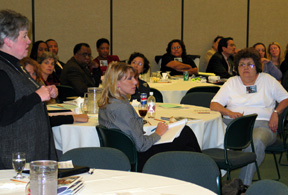 |
Conference attendees work to resolve health disparity issues. |
Several panelists said universal health insurance would help eliminate disparities, as would the expansion of case-workers or promotoras (Spanish speaking people from the community who work to promote health). Others said improvements would be made by creating healthier families, offering more preventive services and educating the community on the health-care system and use of generic prescriptions.